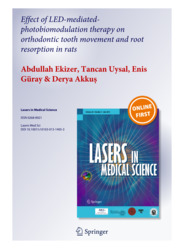Effect of LED-mediatedphotobiomodulation therapy on orthodontic tooth movement and root resorption in rats
-
Eser Sahibi
TANCAN UYSAL
-
Tür
Makale
- Yayın Tarihi 2013
- DOI Numarası 10.1007/s10103-013-1405-3
-
Yayıncı
Springer
- Dergi Adı Lasers in Medical Science
- Tek Biçim Adres Http://hdl.handle.net/11469/161
-
Konu Başlıkları
Low-level laser therapy
Tooth movement
Orthodontics
Rats
The aim of this experimental study was to evaluate
the effects of light-emitting diode-mediated-photobiomodulation
therapy (LPT), on the rate of orthodontic tooth movement (TM)
and orthodontically induced root resorption, in rats. Twentymale
12-week-oldWistar rats were separated into two groups (control
and LPT) and 50 cN of force was applied between maxillary left
molar and incisor with a coil spring. In the treatment group, LPT
was applied with an energy density of 20 mW/cm2 over a period
of 10 consecutive days directly over the movement of the first
molar teeth area. The distance between the teeth was measured
with a digital caliper on days 0 (T0), 10 (T1), and 21 (T2) on
dental cast models. The surface area of root resorption lacunae
was measured histomorphometrically using digital photomicrographs.
Mann–Whitney U and Wilcoxon tests were used for
statistical evaluation at p <0.05 level. TM during two different
time intervals (T1–T0 and T2–T1) were compared for both
groups and a statistically significant difference was found in
the LPT group (p =0.016). The TM amount at the first time
period (1.31±0.36 mm) was significantly higher than the
second time period (0.24±0.23 mm) in the LPT group.
Statistical analysis showed significant differences between
two groups after treatment/observation period (p =0.017).
The magnitude of movement in the treatment group was
higher (1.55±0.33 mm) compared to the control group
(1.06±0.35 mm). Histomorphometric analysis of root resorption,
expressed as a percentage, showed that the average
relative root resorption affecting the maxillary molars on
the TM side was 0.098±0.066 in the LPT group and 0.494±
0.224 in the control group. Statistically significant inhibition
of root resorption with LPT was determined (p <0.001) on the
TM side. The LPT method has the potential of accelerating
orthodontic tooth movement and inhibitory effects on orthodontically
induced resorptive activity.


 Tam Metin
Tam Metin

